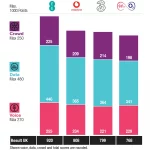ITS Technology Claims First Live UK Biz Customer Trial of 50Gbps PON

The ITS Technology Group, which has built various open access full fibre broadband and Ethernet networks (“Faster Britain“) across urban parts of the UK for businesses and ISPs, today claims to have “become the first UK provider” to successfully trial the delivery of dedicated internet access services over 50G PON broadband tech (both in the lab and via a live business environment).
The claim is somewhat debatable, since Openreach recently conducted its own test of the 50Gbps (Gigabits per second) capable Fibre-to-the-Premises (FTTP) technology with Nokia (here), which connected to a residential property in Ipswich (Suffolk, England). Similarly, Ogi are working toward a similar trial of 50G PON in Wales (here), while Netomnia are working with Adtran to conduct a commercial launch (here), but this has faced delays.
In the case of ITS Technology, the new trial was conducted with Nelson-based Limitless Digital Group and is the first of “several planned tests” across the UK. ITS said they’re building a bank of scalable, real-world use cases to support the roll-out of 50G-PON and shape how next-gen networks are adopted by enterprise, public sector, infrastructure partners, and smart city developers.
Advertisement
During the trial, the ITS team observed 50G-PON speeds of 41.8Gbps downstream and 19.2Gbps upstream. This was while using combi-optics to deliver GPON and XGS-PON services, allowing ITS to deliver 50G-PON leased line services over existing networks without disruption to service.
Mike Goodwin, ITS’ Chief Technology Officer, said:
“While the industry roadmap points to 2026 or 2027 for commercial rollout, our view is simple: business customers are ready now. It is one of ITS’s strategic objectives to stay at the forefront of pioneering technology such as this.
We know from the recent ISPA conference, the conversation was about who survives and thrives. It comes down to great products, great service, and great value. 50G-PON ticks all those boxes – and more.”
The market demand for business-grade symmetrical 10Gbps services is said to be “already well established in ITS’s base”. Traditionally served via point-to-point fibre, the provider claims that 50G-PON “now offers a more sustainable and efficient way to deploy high-capacity services using existing fibre infrastructure“.
Key Use Cases Identified by ITS
➤ 5G Deployment: With the increasing need for dense 5G coverage, 50G-PON can deliver the high-throughput fibre connectivity required to support small cell deployment – especially in mobile not-spot areas where localised fibre access can close the gap.
➤ Large multi-occupancy units and mixed-use developments: As vertical high streets and large-scale residential or mixed-use buildings become more common, 50G-PON supports their need for always-on, high-speed access – futureproofing digital cities with capacity for localised, high-bandwidth demand.
➤ 10Gb+ Business Services: Business customers requiring 10Gbps symmetrical and above can now be served more cost-effectively, with less fibre strain and faster deployment.
➤ Environmental Sustainability: 50G-PON coexists with XGS-PON and GPON on the same network, significantly boosting bandwidth without additional civil works. This enables UK fibre infrastructure to evolve without repeated, disruptive build cycles.
The usual catch in all this is the difficulty of actually being able to harness all that speed when online. Most internet services still seem to struggle to harness more than 1000Mbps, assuming they can do even that, while the multi-gigabit domain remains more of a luxury (Why Buying Gigabit Broadband Doesn’t Always Deliver 1Gbps). But technological evolution rarely waits for the slowest users and 50G PON could be a lot cheaper for some types of businesses than a leased line, although in that scenario it would still need to be backed up by a sturdy Service Level Agreement (SLA).
Mark is a professional technology writer, IT consultant and computer engineer from Dorset (England), he also founded ISPreview in 1999 and enjoys analysing the latest telecoms and broadband developments. Find me on X (Twitter), Mastodon, Facebook, BlueSky, Threads.net and Linkedin.
« BT Group to Shift Remaining International Business into New Unit























































Who needs 50 Gbps. Am happy with 910 Mbps
it is pretty unlikely that anyone will need a 50Gbps connection to their home in the near future, but multi gigabit connections are becoming more commonplace in B2B. On XGSPON networks, each 10Gb connection takes up a port, and bypasses the PON architecture, effectively needing to be deployed as Point to Point connections. This increases port and fibre utilisation, and reduces efficiency.
on a 50G-PON network multiple High Capacity services can be fed from the same port, creating efficiency benefits and enabling remote upgrade paths from low bandwidth to high bandwidth services without the need for an engineer visit.
It did say in the article for business space, multi occupancy buildings. A use case I can think of is managed office space, or shared office spaces such as WeWork. You pay for the office and you can get the Internet packaged with that. If you have 10-20 offices, you can then supply prettty quick connection through a single connection point.
Sorry this person doesn’t represent what Scotland doesn’t want
Yet another company claims first for 50G PON. Previously residential now business just to get a press release! ITS have just purchased or borrowed some demo kit like any altnet can.
It’s great to see the manufacture innovation, but it’s not ready yet for commercial launch. ONT are far too big and expensive for use outside a handful of very unique use cases which for now are best serviced with non PON technologies.
Those business requiring 10Gbps symmetrical services today likely also require high SLAs which can’t be achieved over shared PON infrastructure.
The power of marketing is not something to be ignored :). There’s value in presenting yourself as forward looking with cutting edge technology, even if the reality of getting such things to a practical, commercially viable, market may take a bit longer. Bragging rights over speed is nothing new to the broadband sector.
ISP Engineer SLAs in terms of repair time or in terms of performance?
Repair time doesn’t need to be much different from point to point if hardware fails or fibre breaks. The customers impacted points to the SPoF.
Performance not an issue for the same reasons regular DIA is fine riding over shared infrastructure once it reaches the backhaul. Bandwidth on the PON isn’t a free for all: even on the upstream it’s controlled in 125 microsecond slices.
@Polish – No, reliability and the associated repair time. There are many more components in the passive path. Performance differences would only be a problem for very specific industries such as finance.
The access network is entirely passive and unsure how much higher the failure rate will be versus DIA. Both have intermediate splicing, splitters have been doing their thing for a couple of decades in early BPON adopters.
I don’t know the MTBF on the PON access network but far more likely the kit lighting the fibre fails before the passive fibre does. Most operators have a dedicated fibre per CBT port spliced into splitter much as a DIA drops a customer using a core on a low fibre count cable that gets spliced into a higher fibre count cable and maybe that spliced again before it gets to the ODF.
Some DIA is delivered with active equipment in the field, too. WDM kit to reduce fibre count.
Be interesting to see the failure rate. There’s the usual spike at and soon after install on both DIA and PON but it seems very solid as long as it’s built right. Connectorised to CBT then all spliced. No idea how much they deployed but know Openreach were planning on using CBTs for both DIA and PON, the DIA just going around the splitter node while the other fibres from the CBT are spliced into it.
In same way Virgin Media in 2014 said there planing IPv6. Still very lacking IPv6 there.
https://www.havevirginmediaenabledipv6yet.co.uk/